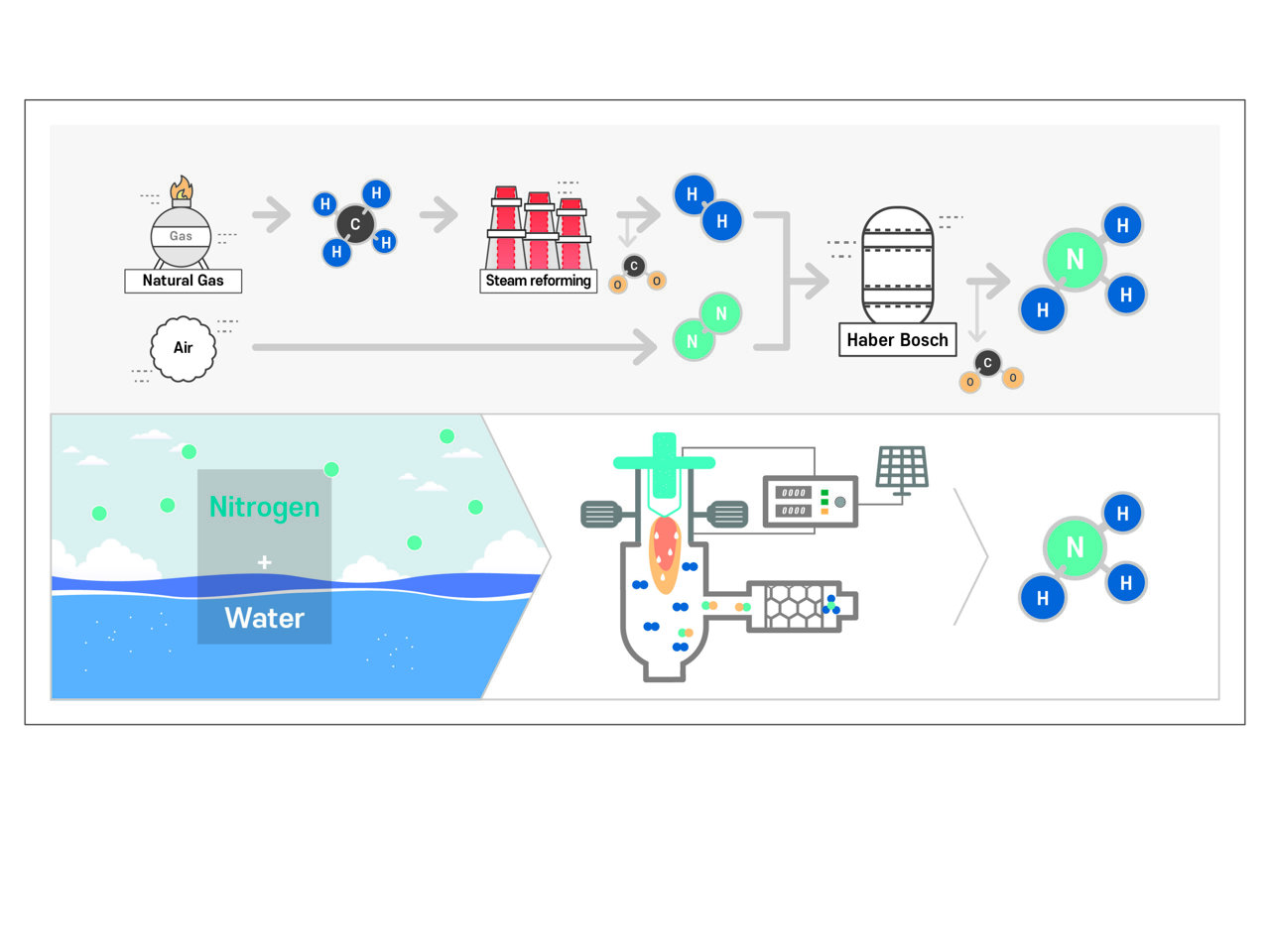
Our society is in need of ammonia more than ever.
Chemical fertilizers, plastic, fibers, pharmaceuticals, refrigerants in heat pumps, and even explosives all use ammonia as raw material. Moreover, ammonia has been suggested as a hydrogen carrier recently because of its high hydrogen content.
In the Haber-Bosch process, which is the main method of ammonia synthesis, nitrogen reacts with hydrogen using a metal catalyst to produce ammonia. However, this industrial process is conducted at 200 atm and high reaction temperatures of nearly 500°C (approximately 932°F). Additionally, ammonia production requires using much natural gas, so scientists have been looking for alternative methods to sustainably synthesize ammonia at low temperature.
In a recent study, researchers from Waseda University and Nippon Shokubai Co. Ltd. achieved a highly efficient ammonia synthesis at low temperature, with the highest yield ever reported.
“By applying an electric field to the catalyst used in our experiment, we accomplished an efficient, small-scale process for ammonia synthesis under very mild conditions,” says Professor Yasushi Sekine of Waseda University. “Using this new method, we can collect highly pure ammonia as compressed liquid and open doors to developing on-demand ammonia production plants that run on renewable energy.”
This research was published in Chemical Science.
In 1972, ruthenium (Ru) catalyst with alkali metals was found to decrease the reaction temperatures and pressures necessary for Haber-Bosch processing, and different methods have been suggested since this discovery. Unfortunately, the ammonia synthesis rate was hindered by kinetic limitations.
“We applied direct current electric field to the Ru-Cs catalyst for our ammonia synthesis and obtained remarkably high ammonia field of approximately 30 mmol gcat-1h-1 with high production energy efficiency. Not to mention, this was done at low reaction temperatures and pressures from atmospheric to 9 atm, which is kinetically controllable. The energy consumption to produce ammonia was very low as well.”
The researchers were able to obtain such results by a mechanism called surface proton hopping, a unique surface conduction triggered by an electric field.
“Our experimental investigations, including electron microscope observation, infrared spectroscopy measurements, and isotopic exchange tests using nitrogen gas, prove that proton hopping plays an important role in the reaction, as it activates nitrogen gas even at low temperatures and moderates the harsh condition requirements,” explains Professor Sekine.
The new technique also addresses obstacles in conventional ammonia synthesis, such as hydrogen poisoning of Ru catalysts and delay in nitrogen dissociation. Furthermore, the research results suggest that smaller-scale, more dispersed ammonia production could be realized, and building highly-efficient ammonia plants that run on renewable energy will become possible. Such ammonia plants will be expected to produce 10 to 100 tons of ammonia per day. Professor Sekine believes that their findings will be important for future energy and material sources.
Learn more: Ammonia on-demand? Alternative production method for a sustainable future
The Latest on: Ammonia production
[google_news title=”” keyword=”ammonia production” num_posts=”10″ blurb_length=”0″ show_thumb=”left”]- Green Ammonia Market Size is Projected to Reach USD 62.1 Billion by 2031, Growing at a CAGR of 77.78%: Straits Researchon April 30, 2024 at 5:21 am
The global green ammonia market’s major key players are Aker Clean Hydrogen, CF Industries Holdings, Inc., Air Products Inc., Haldor Topsor A/S, Fusion-Fuel, HY2GEN AG, Eneus Energy Limited, Hive ...
- Green Ammonia Market Size, Share, Outlook And Forecast Till 2031on April 29, 2024 at 11:23 pm
Carbon emissions can be decreased through sustainable production and carbon-free products. Customers favor green ammonia because it lowers carbon emissions in the energy and shipping industries. The ...
- To lower emissions, a Minnesota startup wants to convert diesel engines to burn ammoniaon April 23, 2024 at 3:00 am
Ammonia doesn’t emit carbon dioxide when burned, but its energy-intensive production mostly relies on fossil fuels, so its benefits depend on sourcing “green” ammonia from renewable power.
- Green Ammonia Market To USD 29.53 Billion By 2031 Driven By Rising Investment In Renewable Energy Projects And Declining Power Generation Costson April 21, 2024 at 12:55 am
An economic slowdown could also potentially impact the market. Reduced investments in renewable energy projects could hinder the adoption of green ammonia technologies. However, the long-term ...
- NGK, Mitsubishi Heavy join forces for ammonia-derived hydrogen purificationon April 19, 2024 at 4:36 am
A new hydrogen purification system that uses membrane separation to purify from hydrogen-nitrogen mixture gas after ammonia cracking is to be developed by NGK Insulators, Ltd., (NGK) and Mitsubishi ...
- ReNew Energy, JERA sign agreement to explore green ammonia project, eyeing 100,000 tonne annual output by 2030on April 18, 2024 at 8:14 pm
ReNew Energy Global plc and JERA Co., Inc sign agreement to explore green ammonia production project in Paradip, Odisha. Collaboration aims to produce 100,000 tons of green ammonia annually by 2030, ...
- ReNew partners with Japan's JERA to evaluate joint development of green ammonia project in Indiaon April 18, 2024 at 5:26 am
ReNew Energy and JERA collaborate on green ammonia project in Paradip, utilizing renewable energy for 100,000 tons production annually by 2030. The project aligns with India's hydrogen goals and Japan ...
- CF Industries And Japan's JERA Explore Low-Carbon Ammonia Production: Detailson April 18, 2024 at 4:44 am
CF Industries Holdings Inc (NYSE:CF) embarks on a groundbreaking partnership with JERA Co Inc, Japan's energy giant, to pioneer low-carbon ammonia production. Set to unfold at CF Industries' Blue ...
- CF Industries, JERA To Explore Development Of Greenfield Low-carbon Ammonia Production Capacityon April 17, 2024 at 7:51 pm
(RTTNews) - CF Industries Holdings Inc. (CF), a producer of ammonia, and JERA Co., Inc. (JERA), an energy company in Japan, said that they have executed a joint development agreement to explore the ...
- CF Industries and JERA Announce Joint Development Agreement to Develop Greenfield Low-Carbon Ammonia Production Capacity in the United Stateson April 17, 2024 at 6:00 pm
CF Industries Holdings, Inc. (NYSE: CF), the world’s largest producer of ammonia, and JERA Co., Inc. (JERA), Japan’s largest energy company, today announced that they have executed a joint development ...
via Google News and Bing News










